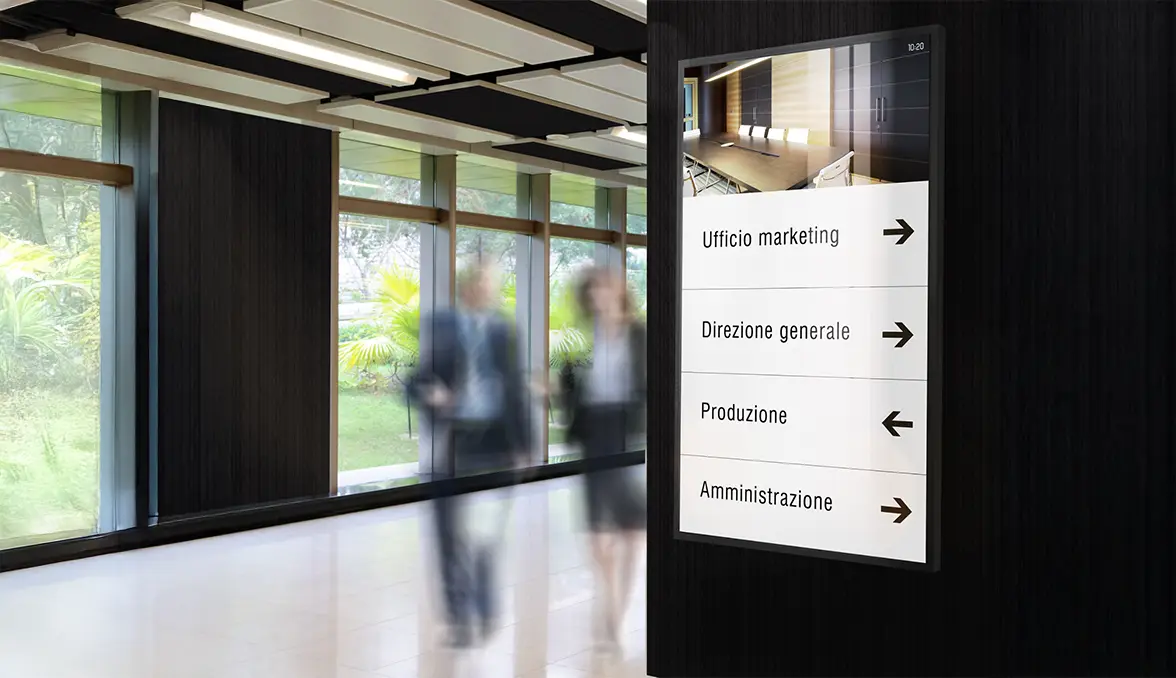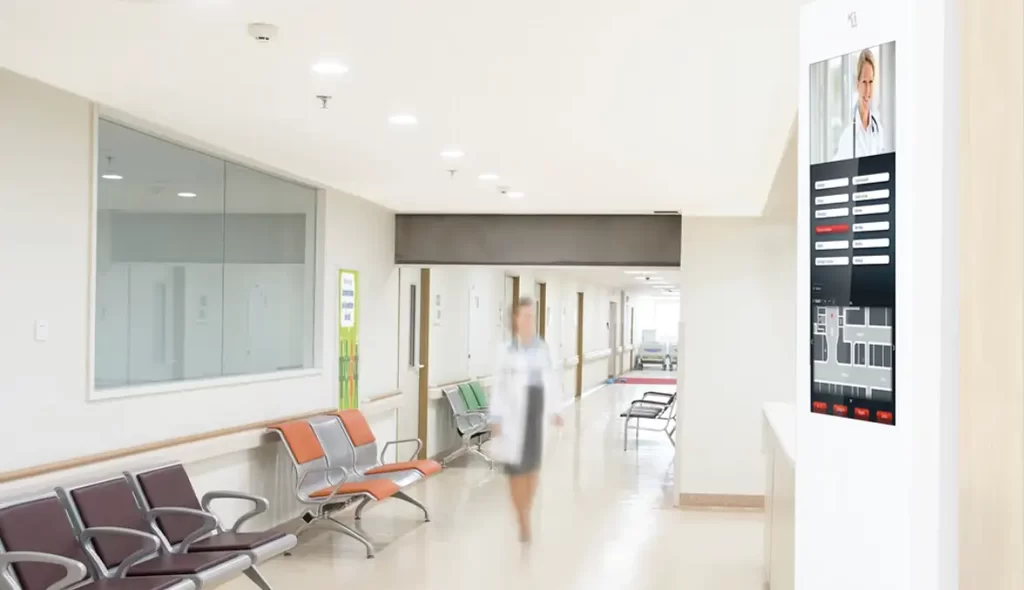Introduction: the importance of signage for users, companies and citizens
Think about it for a moment: how many times a day do we interact with signage, perhaps without even realizing it?
Whether it’s finding the right platform at the station, following directions to an office in a large building, or simply understanding where a pedestrian area begins, signage is a constant and silent presence in our lives.
Its importance is truly crucial, because it directly influences the experience of everyone: users, citizens, customers and suppliers, both in public and private environments.
Imagine being in a crowded airport: without clear and well-positioned signage, the risk of getting lost or not finding the gate in time would be very high, generating stress and frustration.
Similarly, on a construction site, effective safety signage is vital to prevent accidents and protect workers.
And in a shopping center, clear indications about the shops and services make the visit more pleasant and encourage purchases. In essence, well-designed signage has the power to significantly improve the usability of spaces, making it easier and more intuitive to move around and interact with the surrounding environment, and consequently, reducing the risk of making mistakes or feeling disoriented.
Today, creating an effective signage system is no longer something that can be improvised.
It has become a real strategic process that requires skills in various fields, from design to ergonomics, up to the use of the most modern digital technologies.
The advent of mini displays, interactive totems and sophisticated digital signage solutions has opened new frontiers, allowing complex orientation problems to be addressed with immediate and effective solutions, ensuring clear and timely communication.
Digital signage and wayfinding systems
The way we orient ourselves in complex spaces is undergoing a real revolution thanks to digital wayfinding systems.
Forget static maps that are often difficult to interpret! Today we have interactive and dynamic tools that guide us step by step towards our destination.
Think of the interactive totems that we find more and more often, equipped with detailed digital maps that we can consult with a simple touch.
Or imagine the large LED video walls, the so-called LEDwalls, installed in hospital entrances that provide clear and up-to-date information on the departments and routes to follow.
This “smart signage” not only makes it easier to find your way, but it also improves overall efficiency, significantly reducing the time it takes people to get to their destination.
In contexts such as hospitals or large offices, where time is often precious, this translates into better service and less frustration for users.
Types of signage by purpose
Each place and situation has unique needs, and therefore requires a specific type of signage. To better understand the variety of solutions available, we can divide signage into different categories, based on their main function:
Identification Signage
Purpose: The primary objective of this signage is to make places and spaces immediately recognizable. It is the first impression that an environment offers.
Examples: Let’s think about the corporate and commercial signs that we see on the street, which allow us to identify a shop or a company. This category also includes the identification plates that we find at the entrance to offices and departments within a building, as well as the panels with the names of streets and squares that help us orient ourselves in the city.
Directional Signage
Purpose: This type of signage has the fundamental task of guiding people clearly and unambiguously to a specific destination.
Examples: The directional arrows that we find in airports, hospitals and large shopping centers are a classic example. Indicative road signs, with their signs that show us the direction to reach a certain location, are also part of this category.
Finally, interactive maps and QR codes that we can scan with our smartphone to obtain guided routes represent more modern and interactive solutions.
Good internal and external signage in shopping centers facilitates navigation, helps customers find the desired stores and services, and improves the overall shopping experience.
Studies on consumer behavior indicate that clear signage can increase the time spent inside a shopping center and, potentially, spending.
Orientation Signage
Purpose: Unlike directional signage that indicates a specific route, orientation signage provides an overview of spaces, helping people understand where they are in relation to the surrounding context.
Examples: Emergency plans and evacuation maps, crucial in case of danger, fall into this category. Likewise, interactive digital maps that we find in parks or museums help us understand the general layout of the area.
➤ NOTE: Feedback from museum visitors often mentions the quality of signage as a key factor in a satisfactory visit.
Welcome panels at the entrance of a building, with the layout of the various offices or services, also perform an orientation function.
Effective signage in Airports and Stations reduces confusion, delays and missed connections. Passengers feel more confident and autonomous in navigating complex spaces.
A survey of passengers at an international airport found that 85% considered clear signage to be a crucial factor in a positive travel experience.
Safety Signs
Purpose: The top priority of this signage is to prevent risks and ensure the safety of people by providing crucial warnings and directions.
Examples: Signs indicating emergency exits and escape routes in the event of a fire are essential.
Likewise, hazard warnings, such as those relating to slippery floors or areas with machinery in operation, and signs indicating regulatory obligations, such as the mandatory use of Personal Protective Equipment (PPE) in certain work environments, are essential for safety.
Signage used for emergency management, such as indications of assembly points, also falls into this category.
Regulatory Signs
Purpose: This sign is used to communicate obligations and prohibitions, ensuring compliance with rules and regulations.
Examples: Road signs indicating speed limits or no parking are well-known examples. Similarly, signs indicating “no smoking” or “no entry for unauthorized personnel” fall into this category.
Company regulations displayed in public areas, such as rules of conduct within an office, are also a form of regulatory signage.
Informative Signs
Purpose: The purpose of this signage is to provide useful and relevant information, without imposing specific obligations or prohibitions.
Examples: Signs indicating the opening hours of a shop or office are a common example. Digital displays that show news, events or useful information to the public also fall into this category.
In museums, descriptive panels next to works of art are a form of informative signage that enriches the visitor experience.
Digital and Interactive Signage
Purpose: This type of signage uses technology to offer dynamic information, which can be updated in real time and is often interactive, improving the user experience.
Examples: Touchscreen kiosks that allow you to make reservations, get detailed information or display interactive maps are an example. LED displays used for queue management, to show important notices or to communicate departure and arrival times fall into this category.
Mini displays in stores that show real-time promotions or product information are also part of digital signage.
Accessibility and Inclusion Signage
Purpose: The fundamental objective of this signage is to make spaces accessible and usable by all, taking into account the different needs of people, including those with disabilities.
Examples: Braille signage for the blind, tactile routes and audio descriptions for the visually impaired are important examples. Signs indicating parking spaces reserved for people with disabilities or easy access are also part of this category, helping to create more inclusive environments.
The role of technology in signage
As we have already mentioned, the integration of digital technologies is profoundly transforming the world of signage. It is not just a matter of replacing old signs with bright screens, but of making information clearer, constantly updated and easily accessible in real time.
Let’s look at some concrete examples of how technological innovation is revolutionizing this sector:
- Digital kiosks with artificial intelligence: Imagine approaching a kiosk and being able to interact with a virtual assistant that can answer your questions, provide you with personalized directions and even help you find a specific product in a store. Artificial intelligence integrated into digital kiosks makes user assistance more efficient and tailored.
- Wayfinding systems with mobile apps and augmented reality: Thanks to smartphone apps and augmented reality, orienting yourself inside a large building or a hospital complex becomes a completely new experience. Simply point your phone’s camera at your environment to see virtual arrows superimposed on reality, guiding you exactly where you need to go.
- Adaptive LED Signs: These smart displays have the ability to change their content based on factors such as the time of day, traffic conditions, or the amount of people in a given area. For example, a sign in an airport could show information about departing flights during the day and special offers from stores in the evening.
- Digital Route Mapping Kiosks: These tools are especially useful in large and complex environments such as shopping malls, airports, and university campuses. With interactive digital maps, users can easily locate their destination and see the shortest route to get there. Kiosk Wayfinder does just that.
- Large LED wall wayfinding systems: Strategically placed, often in the entrances of facilities such as hospitals, these large screens provide a clear and immediate overview of the layout of the spaces, helping visitors quickly find the department or office they are looking for.
- Digital touch screen door systems: Ideal for offices, hotels and healthcare facilities, these small screens installed outside rooms or offices allow you to display detailed information about them, such as the name of the occupant or the opening hours, and in some cases also offer the possibility of booking appointments via an interactive interface. Kiosk Targa is an example of this application
These technological solutions not only significantly improve the user experience, making navigation easier and more pleasant, but also offer significant advantages for companies, eliminating costs and waste of resources related to printing and continuous replacement of paper signs.
The flexibility and dynamism of digital signage allow you to communicate information that is always up-to-date and relevant.
Signage design: why you can’t improvise
An effective signage system doesn’t happen by chance. It requires careful and meticulous design, based on clear criteria of visibility, readability and graphic coherence.
Unfortunately, it is easy to come across examples of improvised signage, with unclear signs, contradictory indications or incorrect positioning. These seemingly trivial errors can generate confusion, frustration and, in the worst cases, compromise people’s safety.
Designing a signage system is a complex process that involves different professional figures with specific skills.
Wayfinding experts, designers, architects and visual communication engineers work together to create optimal solutions.
A successful project always begins with a detailed inspection of the environment, during which the spaces, the flow of people, the lighting conditions and the possible critical orientation points are carefully analyzed.
This step is absolutely crucial to determine the strategic positioning of the signage, ensuring that it is easily visible and understandable for all users, regardless of their origin or their abilities.
Another fundamental aspect is the choice of materials and technologies to be used. For outdoor environments, for example, it is necessary to opt for materials that are resistant to the elements and wear and tear of time. For indoor environments, however, you can choose more refined solutions that are integrated with the surrounding architectural design.
As we have seen, digital signage, with its interactive totems, mini displays and LED panels, offers an additional advantage: the ability to update information quickly and dynamically, reducing maintenance costs and constantly improving the user experience.
Relying on industry experts is therefore the wisest choice to ensure an effective and functional signage system. These professionals will be able to recommend the most suitable solutions, taking into account several crucial factors:
- Installation environment: Whether it is an indoor or outdoor environment, with good or poor lighting, the characteristics of the place influence the choice of materials and technologies.
- Target users: It is essential to consider who will use the signage: customers, citizens, employees, visitors with specific needs (such as the elderly or people with disabilities).
- Regulations in force: Especially for safety signs, it is essential to comply with the laws and regulations in force to ensure compliance and protection of people.
- Ergonomics and perceptibility: Size, colors, optimal contrasts and choice of fonts are crucial elements to ensure good readability and comprehensibility of messages.
- Technology and sustainability: The choice of digital solutions and eco-friendly materials can not only improve the effectiveness of the signage, but also reduce the impact environmental.
In conclusion, a well-designed signage system goes far beyond simply indicating a route. It improves navigation, increases safety, contributes to the aesthetic enhancement of the environment and reinforces the positive perception of the organization that implements it.
The Link Between Brand Identity and Signage
Signage is not simply a practical tool to help us move around a space. It also plays a significant role in building and strengthening a brand’s identity.
Especially in corporate contexts with a high flow of people or with a strong market presence, visual consistency between signage and brand identity is essential to communicate professionalism, reliability and the distinctive values of the company.
Think of large companies with distributed offices, luxury hotel chains, international airports or retail chains with outlets in different cities. In these contexts, every single sign, from the choice of colors to the type of font used, must be perfectly in line with the brand’s coordinated image.
This visual coherence not only strengthens the public’s recognition of the brand, but also contributes to improving the overall user experience. A well-designed signage project does not just facilitate orientation, but creates a harmonious and distinctive environment, increasing the perception of quality and prestige of the brand.
Effective signage must therefore scrupulously respect the visual language of the brand, using graphic elements consistent with the corporate image.
This means that colors, typography, icons and even the tone of communication must be designed with great care to ensure a positive and memorable impact.
For example, a brand that positions itself in the luxury segment could opt for minimalist signage, made with refined materials such as glass and metal, while a supermarket chain will focus on more lively, colorful and easily readable signage even from a distance.
Furthermore, it is important to underline that signage is a fundamental component of the customer experience. A well-structured and intuitive path within a store or exhibition space positively influences purchasing decisions and the perception of the service offered.
Clear, well-positioned and easy-to-understand signs reduce customer frustration, making the interaction with the space smoother and more effective. For this reason, signage design should not be considered a secondary element to be added at the end, but an integral part of the overall branding strategy.
It is important to note that the effectiveness of signage depends on several factors, including:
- Clarity and simplicity of design.
- Correct location and size.
- Use of symbols and universal language.
- Visual consistency.
- Regular maintenance.
Conclusion
In conclusion, signage is not just a functional element, but a crucial factor that significantly influences the daily life of citizens and the experience of users in a wide range of contexts.
Well-designed and implemented signage leads to tangible benefits in terms of safety, efficiency, stress reduction and improved overall satisfaction.
Have you understood the strategic importance of effective signage for your business?
Do you want to explore how customized and innovative solutions can improve the orientation of your spaces and strengthen your brand identity?
 | Contact us today.Schedule a free call with our experts! We’ll analyze your specific needs and show you the best strategies to reach your goals. |
 |
Contact us todaySet up a free call with our experts!
|




